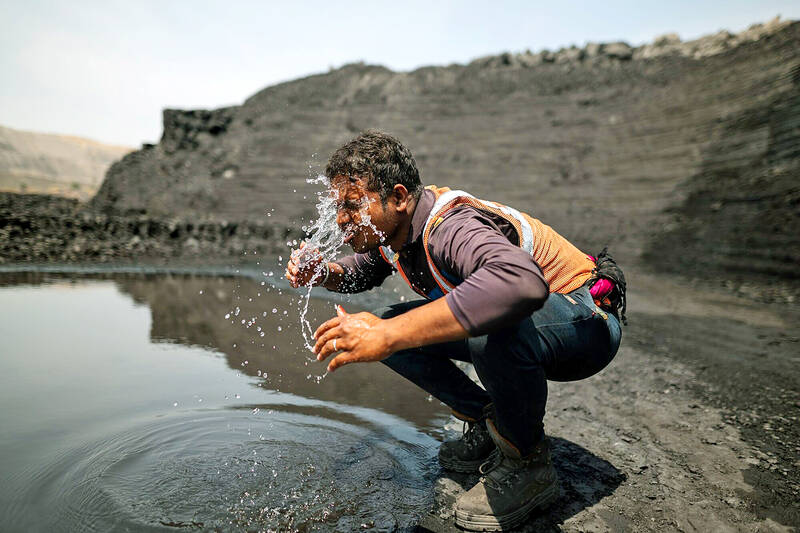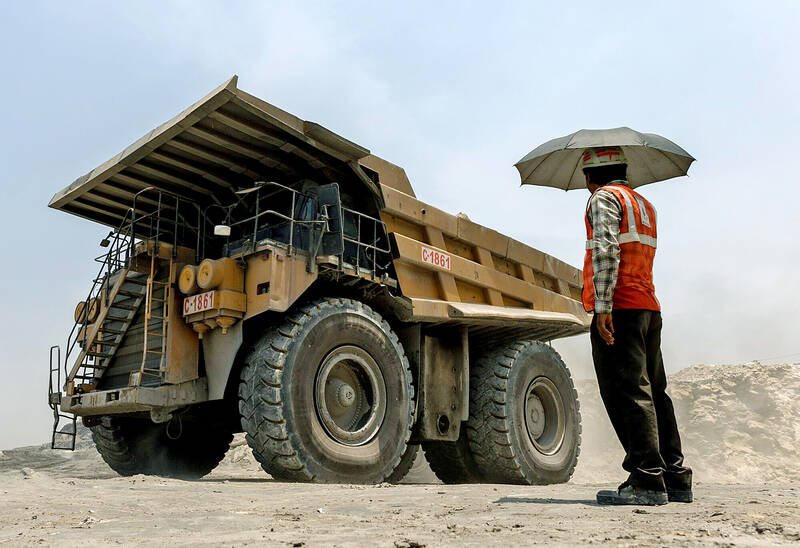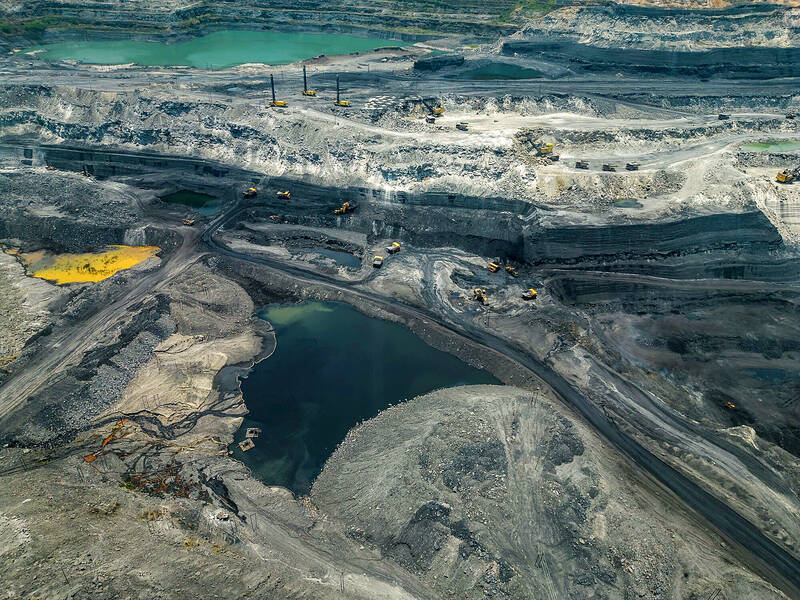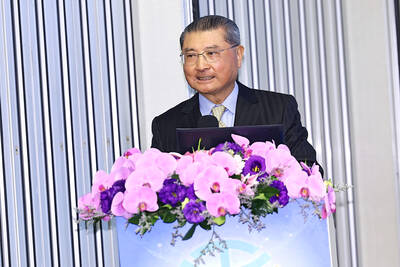Standing by vast, ash-colored coalfields, miner Rabi Behera expressed few doubts about the job at hand. To cope with increasingly brutal temperatures, India has to keep its power grid standing — and for now that means digging up ever-expanding quantities of the dirtiest fossil fuel.
“It’s hard to survive without electricity during the summer,” he said, as giant trucks rumbled past in clouds of black dust. “Our production target is raised every year. Every year we’re producing more coal.”
So far, this year has been less blistering than last year, when temperatures in New Delhi climbed past 49°C, but February still broke records, April saw lethal conditions and forecasters issued warnings for this month, when pre-monsoon heat tends to peak.

Photo: Bloomberg
Extreme temperatures are increasingly frequent, and that’s driving electricity consumption surges, which in turn push up demand for fuel from vast pits such as one in Gevra in the eastern state of Chhattisgarh, where Behera works — soon to become the largest coal mine in the world.
Wealthy nations are, by and large, moving away from coal, the single largest contributor to climate change, the International Energy Agency says.
However, even with considerable advances in renewable energy, the world’s most populous country still relies on the black stuff for roughly three-quarters of power generation, and would need it for years to come. The fuel is relatively cheap, and, crucially for an energy-importing economy, readily available domestically.

Photo: Bloomberg
As a result, India is now the third-largest emitter of greenhouse gases, even if it still lags China and the US, and per-capita figures remain below the global average. A vast, climate-vulnerable nation is making its own predicament worse, leaving hundreds of millions of its workers caught in a vicious heat cycle — with all the health and economic productivity costs that come with toiling in sweltering conditions.
A 2020 McKinsey Global Institute report said that as of 2017, heat-exposed work contributed to about half of India’s GDP, and a third of GDP growth.
It is not just about rising mercury. The combination of heat and humidity might make parts of India some of the world’s first uninhabitable places. At high humidity even relatively modest temperatures can compromise the body’s ability to cool itself by sweating. This can lead to fainting, heat stroke and heart attacks.

Photo: Bloomberg
“Heat is not foreign to most countries in South and Southeast Asia. However, at present level of global warming, it is just going beyond the survivability limit,” said Fahad Saeed, an Islamabad-based scientist with Climate Analytics. “The heat is incredibly serious and points to the need for us to reduce emissions as fast and as hard as we can.”
Miners such as Behera find themselves at both ends of the problem.
He helps dig coal for state-owned Coal India Ltd, one of the largest producers globally.
He said he sees the benefit of strong demand and his family enjoys the appliances electricity can power.
He is also among those risking the worst of the consequences, laboring daily in a black, shade-free moonscape. Unlike truck drivers who can take refuge in air-conditioned vehicles, Behera, a supervisor, spends his days outside, in a region where temperatures have topped 49°C.
Behera pointed out a small kiosk, insulated with wooden sheets, where workers can rest or eat in the shade, one of the measures the company has taken to mitigate the heat. Workers in hard hats and sunglasses walked past, their faces covered with scarves to protect against the heat and debris. Most employees carry oral rehydration salts, just in case. An ambulance is always on stand-by.
Temperatures always spike before the monsoon hits around June, but blistering, life-threatening levels like those reached last year, and tested again this year, are becoming more common. A changing climate has made extreme heat 30 times more likely in India.
There are consequences for agriculture in a country that has 1.4 billion people to feed, already frets about import bills and can roil world markets. Last year, severe heat forced the second-biggest producer of wheat to ban exports, fueling fears about global shortages as the war in Ukraine upended supply chains.
In the eastern state of Odisha, dairy farmer Manoj Kumar Behera described falling milk output as even mixed breeds among his 25 cows and calves struggle to tolerate the heat. With intermittent electricity supply, he has few options but to deal with the losses.
“When we ask about power cuts, we are told it’s happening due to abnormal demand for electricity during summer months,” he said, as his workers fed the cows nearby. “Sometimes when it gets too hot in the shed, we have to bring the cows out to rest under the trees.”
Production falls by close to one-third in such heat, he said.
The effect is far wider, threatening overall productivity, long-term health and even survival, as hundreds of millions are exposed to extreme conditions — a greater proportion of the population than anywhere else globally. Heat might lower the quality of life for almost 600 million Indians by 2100.
That means the myth that India, a hot country, can cope with extreme heat must be dispelled, said engineer and computational social scientist Ramit Debnath at the University of Cambridge.
He researches climate misinformation and last month published a study on the effects of heat on development.
“I received comments, including from doctors, saying Indians have their own way of coping with heat wave, so, it’s not a very big problem,” he said. “The notion that Indians are more resilient to heat than people elsewhere is misinformation.”
Awareness is growing. The government has developed heat action plans, providing guidelines for state, district and city authorities on how to respond.
Indian Prime Minister Narendra Modi led a meeting in March to review preparedness for hot weather conditions.
However, heat waves are not explicitly among the disasters eligible for relief under the National and State Disaster Response Funds, and a study of state and city-level heat action plans by the Centre for Policy Research think tank found significant gaps.
The blueprints for New Delhi, a metropolis of 33 million which smashed temperature records last year, have yet to be released.
The state government directed a request for comment to the local disaster management authority, which directed queries to the pollution control board. The pollution control board did not comment.
Meanwhile, official definitions of heat waves still focus only on temperature thresholds — not on the effects of high humidity or the link to smog.
“Heat waves can intensify air pollution and that’s simple physics: Pollutants won’t be able to escape because of the heat,” said Ronita Bardhan, an architectural engineer at the University of Cambridge who researches sustainability and also worked on the heat study.
Companies have largely been left to deal with the problem as they see fit.
Food delivery start-up Zomato Ltd provides rest stops for riders to take a break between deliveries, offering clean drinking water, first-aid kits and access to washrooms. Other e-commerce firms provide sports drinks or replace less breathable uniforms with material suited for hot weather.
There are also pressures to meet targets. In the Talcher coalfields in Odisha, run by a unit of Coal India, a local government directive means outside work should stop in the middle of the day, to prevent heatstroke.
However, work in the opencast mines rarely does, said workers who asked not to be identified as they are not authorized to speak to the media.
Some coal mine officials said they simply do whatever it takes to meet production targets.
Mahanadi Coalfields Ltd, the unit of Coal India, said the order does allow coal mining to continue as it is linked to essential services, specifically power supply.
The company tries to ensure the safety of field workers by limiting their exposure to the sun and maximizing output during cooler times of the day or at night.
“It is possible that [a] couple of workers may not be aware of the order. However, this does not mean we are not conscious of our duties to protect our workers,” it said in response to queries.
The trouble is that India’s power demand is growing. Green development, climate finance and sustainability have been a priority for its G20 presidency this year, but coal is to remain a major part of India’s power sector in the coming decades.
The Indian Central Electricity Authority said coal would account for 54 percent of generation in 2030, and the country is still building coal-fired plants.
“This will delay the amount of emissions that could have been cut off, and that’s a major concern — not just for India, but for across the world,” Bardhan said. “We are not saying that India needs to stop using coal completely at this point, but probably phasing out and understanding the opportunities and potential in renewables, understanding where the investments can happen ... those areas need more discussion.”
The opportunity should appeal as multilateral lenders and even wealthy nations and capital markets push cash toward the energy transition.
BloombergNEF calculates that India would need US$12.7 trillion in supply and demand-side investment to become net zero by 2050. The country aims to reach net zero by 2070.
Modi’s administration raised its goals for clean energy capacity last year. India is offering incentives to add more solar or wind power and aims to become a global hub for production of green hydrogen and green ammonia.
However, New Delhi has also opposed international efforts to set firm deadlines to phase out the use of coal.
With the monsoon still days from making landfall further south, the news is good mostly for air-conditioner sellers such as Vishnu Moorarka, sitting in his electronics shop in Bilaspur, a city on the Chhattisgarh plain, about a two-hour drive from the Gevra mine.
He has been anticipating the start of nautapa later this month, a nine-day period in the Hindu calendar that is traditionally considered the hottest of the season.
“We have stocked up inventory in expectation of high demand,” Moorarka said, with a cluster of air-conditioner units neatly stacked behind him.
His staff have not been allowed to take time off, and his eyes are constantly on his phone for weather alerts, he said.
After a long day at the Gevra mine, Rabi Behera is less optimistic.
“It’s getting hotter than earlier. Trees are being cut, industries and mines are coming up,” he said, at home with his two children. “It will only rise from here.”

When an apartment comes up for rent in Germany’s big cities, hundreds of prospective tenants often queue down the street to view it, but the acute shortage of affordable housing is getting scant attention ahead of today’s snap general election. “Housing is one of the main problems for people, but nobody talks about it, nobody takes it seriously,” said Andreas Ibel, president of Build Europe, an association representing housing developers. Migration and the sluggish economy top the list of voters’ concerns, but analysts say housing policy fails to break through as returns on investment take time to register, making the

‘SILVER LINING’: Although the news caused TSMC to fall on the local market, an analyst said that as tariffs are not set to go into effect until April, there is still time for negotiations US President Donald Trump on Tuesday said that he would likely impose tariffs on semiconductor, automobile and pharmaceutical imports of about 25 percent, with an announcement coming as soon as April 2 in a move that would represent a dramatic widening of the US leader’s trade war. “I probably will tell you that on April 2, but it’ll be in the neighborhood of 25 percent,” Trump told reporters at his Mar-a-Lago club when asked about his plan for auto tariffs. Asked about similar levies on pharmaceutical drugs and semiconductors, the president said that “it’ll be 25 percent and higher, and it’ll

CHIP BOOM: Revenue for the semiconductor industry is set to reach US$1 trillion by 2032, opening up opportunities for the chip pacakging and testing company, it said ASE Technology Holding Co (日月光投控), the world’s largest provider of outsourced semiconductor assembly and test (OSAT) services, yesterday launched a new advanced manufacturing facility in Penang, Malaysia, aiming to meet growing demand for emerging technologies such as generative artificial intelligence (AI) applications. The US$300 million facility is a critical step in expanding ASE’s global footprint, offering an alternative for customers from the US, Europe, Japan, South Korea and China to assemble and test chips outside of Taiwan amid efforts to diversify supply chains. The plant, the company’s fifth in Malaysia, is part of a strategic expansion plan that would more than triple

Taiwanese artificial intelligence (AI) server makers are expected to make major investments in Texas in May after US President Donald Trump’s first 100 days in office and amid his rising tariff threats, Taiwan Electrical and Electronic Manufacturers’ Association (TEEMA, 台灣電子電機公會) chairman Richard Lee (李詩欽) said yesterday. The association led a delegation of seven AI server manufacturers to Washington, as well as the US states of California, Texas and New Mexico, to discuss land and tax issues, as Taiwanese firms speed up their production plans in the US with many of them seeing Texas as their top option for investment, Lee said. The